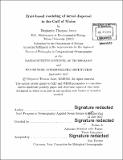| dc.contributor.advisor | Rubao Ji. | en_US |
| dc.contributor.author | Jones, Benjamin Thomas | en_US |
| dc.contributor.other | Woods Hole Oceanographic Institution. | en_US |
| dc.date.accessioned | 2017-12-20T18:16:12Z | |
| dc.date.available | 2017-12-20T18:16:12Z | |
| dc.date.copyright | 2017 | en_US |
| dc.date.issued | 2017 | en_US |
| dc.identifier.uri | http://hdl.handle.net/1721.1/112889 | |
| dc.description | Thesis: Ph. D., Joint Program in Oceanography/Applied Ocean Science and Engineering (Massachusetts Institute of Technology, Department of Biology; and the Woods Hole Oceanographic Institution), 2017. | en_US |
| dc.description | Cataloged from PDF version of thesis. | en_US |
| dc.description | Includes bibliographical references (pages 151-163). | en_US |
| dc.description.abstract | Population connectivity is a fundamental process that governs the spatial and temporal dynamics of marine ecosystems. For many marine species, population connectivity is driven by dispersal during a planktonic larval phase. The ability to obtain accurate, affordable, and meaningful estimates of larval dispersal patterns is therefore a key aspect of understanding marine ecosystems. Although field observations provide insight into dispersal processes, they do not provide a comprehensive assessment. Individual-based models (IBMs) that couple ocean circulation and particle-tracking models provide a unique ability to examine larval dispersal patterns with high spatial and temporal resolution. Obtaining accurate results with IBMs requires simulating a sufficient number of particles, and the sequential Bayesian procedure presented in chapter 2 identifies when the number of particles is adequate to address predefined research objectives. In addition, this method optimizes the particle release locations to minimize the requisite number of particles. Even after applying this method, the computational expense of IBM studies is still large. The model in chapter 3 seeks to increase the affordability of IBM studies by transferring some of the calculations to graphics processing units. Chapter 4 describes three algorithms that assist in interpreting IBM output by identifying coherent geographic clusters from population connectivity data. The first two algorithms have existed for nearly a decade and recently been applied separately to marine ecology, and we provide a direct comparison of the results from each. Additionally, we develop and present a new algorithm that simultaneously considers multiple species. Finally, in chapter 5, we apply these tools and a trait-based modeling framework to assess which species traits are most likely to impact dispersal success and patterns in the Gulf of Maine. We conclude that the traits influencing spawning distributions and habitat requirements for settlement are most likely to influence dispersal. | en_US |
| dc.description.statementofresponsibility | by Benjamin Thomas Jones. | en_US |
| dc.format.extent | 163 pages | en_US |
| dc.language.iso | eng | en_US |
| dc.publisher | Massachusetts Institute of Technology | en_US |
| dc.rights | MIT theses are protected by copyright. They may be viewed, downloaded, or printed from this source but further reproduction or distribution in any format is prohibited without written permission. | en_US |
| dc.rights.uri | http://dspace.mit.edu/handle/1721.1/7582 | en_US |
| dc.subject | Joint Program in Oceanography/Applied Ocean Science and Engineering. | en_US |
| dc.subject | Biology. | en_US |
| dc.subject | Woods Hole Oceanographic Institution. | en_US |
| dc.subject.lcsh | Marine ecology | en_US |
| dc.subject.lcsh | Plankton larval phase | en_US |
| dc.subject.lcsh | Plankton Dispersal | en_US |
| dc.title | Trait-based modeling of larval dispersal in the Gulf of Maine | en_US |
| dc.type | Thesis | en_US |
| dc.description.degree | Ph. D. | en_US |
| dc.contributor.department | Joint Program in Oceanography/Applied Ocean Science and Engineering | en_US |
| dc.contributor.department | Woods Hole Oceanographic Institution | en_US |
| dc.contributor.department | Massachusetts Institute of Technology. Department of Biology | |
| dc.identifier.oclc | 1015183174 | en_US |
